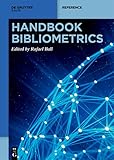Handbook Bibliometrics / ed. by Rafael Ball.
Material type: TextSeries: De Gruyter ReferencePublisher: Berlin ; Boston : De Gruyter Saur, [2020]Copyright date: ©2021Description: 1 online resource (XI, 530 p.)Content type:
TextSeries: De Gruyter ReferencePublisher: Berlin ; Boston : De Gruyter Saur, [2020]Copyright date: ©2021Description: 1 online resource (XI, 530 p.)Content type: - 9783110642278
- 9783110642599
- 9783110646610
- online - DeGruyter
- Issued also in print.
| Item type | Current library | Call number | URL | Status | Notes | Barcode | |
|---|---|---|---|---|---|---|---|
 eBook
eBook
|
Biblioteca "Angelicum" Pont. Univ. S.Tommaso d'Aquino Nuvola online | online - DeGruyter (Browse shelf(Opens below)) | Online access | Not for loan (Accesso limitato) | Accesso per gli utenti autorizzati / Access for authorized users | (dgr)9783110646610 |
Frontmatter -- Preface -- Contents -- Introduction -- 1 History and Institutionalization of Bibliometrics -- 1.1 A Historical Overview of Bibliometrics -- 1.2 Institutionalization and Professionalization of -- Bibliometrics -- 1.3 Eugene Garfield and the Institute for Scientific -- Information -- 1.4 Derek De Solla Price: The Father of -- Scientometrics -- 1.5 Coevolution of Field and Institute: The -- Institutionalization of Bibliometric Research Illustrated by the Emergence -- and Flourishing of the CWTS -- 1.6 International Conferences of Bibliometrics -- 2 Theory, Principles and Methods of Bibliometrics -- 2.1 Peer Review and Bibliometrics -- 2.2 Jurisdiction of Bibliometrics -- 2.3 National Research Evaluation Systems -- 2.4 The Mathematical Embedding of Bibliometrics -- 2.5 Bibliometrics in the Humanities, Arts and Social -- Sciences -- 2.6 Relationship between Peer Review and -- Bibliometrics -- 3 (Classical) Indicators -- 3.1 Measuring the Impact of Research – from Scholarly -- Communication to Broader Impact -- 3.2 From Simple Publication Figures to Complex Indicators: -- Bibliometrics and the Dilemma of Methodological Correctness, Significance, -- and Economic Necessity -- 3.3 The Journal Impact Factor: A Bibliometric Indicator -- with a Long Past -- 3.4 The h-index -- 4 Alternative Metrics (Altmetrics) -- 4.1 The Future Has Already Begun: Origin, Classification, -- and Applications of Altmetrics in Scholarly Communication -- 4.2 History, Development and Conceptual Predecessors of Altmetrics -- 4.3 Social Media and Altmetrics -- 4.4 Altmetric.com: A Brief History -- 4.5 PlumX Metrics (Plum Analytics) in Practice -- 4.6 PLOS Article-Level Metrics -- 4.7 Eigenfactor -- 4.8 Academic Social Networks and Bibliometrics -- 4.9 ResearchGate and the Academic Social Network Sites: New -- Environments for New Bibliometrics? -- 4.10 Mendeley -- 5 Applications, Practice and Special Issues in Bibliometrics -- 5.1 An Ecology of Measures and Indicators: Bibliometrics in -- Resource Allocation -- 5.2 Benchmarkings and Rankings -- 5.3 Technological Trend Analysis -- 5.4 Research Collaboration and Bibliometric -- Performance -- 5.5 On the Need for Accessibility, Standardization, -- Regulation, and Verification in Bibliometrics: The Leiden Manifesto and -- Beyond -- 5.6 Gender and Bibliometrics: A Review -- 5.7 Visualization of Research Metrics -- 5.8 Regional Distribution of Research: The Spatial -- Polarization in Question -- 5.9 Bibliometrics and Co-Authorship -- 6 The Data Basis in Bibliometrics -- 6.1 Web of Science, Scopus and Further Citation Databases -- 6.2 Expanding Dimensions: A New Source in the -- Bibliometrician’s Toolbox -- 6.3 The Islamic World Science Citation Center (ISC): The -- Construction and Application -- 6.4 Institutional Repositories and Bibliometrics -- 7 Teaching and Training -- 7.1 Institutions for Bibliometric Qualification -- 7.2 Bibliometrics in the Curriculum -- 7.3 The Competent Bibliometrician – A Guided Tour through -- the Scholarly and Practitioner Literature -- 8 The Future of Bibliometrics -- 8.1 The Future of Bibliometrics: Where is Bibliometrics -- Heading? -- 8.2 Open Science and the Future of Metrics -- List of Contributors -- Index
restricted access online access with authorization star
http://purl.org/coar/access_right/c_16ec
Bibliometrics and altmetrics are increasingly becoming the focus of interest in the context of research evaluation. The Handbook Bibliometrics provides a comprehensive introduction to quantifying scientific output in addition to a historical derivation, individual indicators, institutions, application perspectives and data bases. Furthermore, application scenarios, training and qualification on bibliometrics and their implications are considered.
Issued also in print.
Mode of access: Internet via World Wide Web.
In English.
Description based on online resource; title from PDF title page (publisher's Web site, viewed 01. Dez 2022)


